
Joyon's latest epic voyage
Distracted by La Solitaire du Figaro last week, we didn’t provide suitable homage to the latest momentous entry in the maritime history books, from French singlehanded sailing legend, Francis Joyon.
In crossing the North Atlantic west to east singlehanded in 5 days 2 hours 56 minutes and 10 seconds, Joyon recovered the record he last set in 2005. On that occasion he became the first person to better Laurent Bourgnon’s epic 1994 record.
On this latest occasion Joyon and his valiant 97ft long Irens-Cabaret-designed trimaran IDEC lopped 16 hours 34 minutes and 30 seconds off the previous New York to the Lizard passage record of 5 days, 19 hours, 30 minutes and 40 seconds. The previous record was set in 2008 by Thomas Coville aboard IDEC’s slightly larger sistership, Sodebo (read more about the boats here).
In his normal manner, Joyon doesn’t going in for ‘slightly’ breaking records and his latest time for the west to east North Atlantic crossing represents a 12% reduction on Coville’s, so not quite the 20% with which he decimated Ellen MacArthur’s outright solo non-stop around the world record back in 2008, but nonetheless a significant reduction.
Impressively with his latest ultra-quick Atlantic passage, Joyon now holds what his team is touting as the complete ‘Grand Slam’ of solo offshore record breaking. With the Transatlantic most recently, this includes non-stop around the world, the Route of Discovery from Cadiz to San Salvador in the Bahamas and the singlehanded 24 hour record of 666.2 nautical miles (27.75 knots) which out of the blue Joyon went off and broke last year sailing out of IDEC’s homeport of La Trinite sur Mer.
As he has for all his record attempts over the last 12 or so years, Joyon worked on this latest one with French expert router Jean-Yves Bernot, a rare example of Joyon collaborating with someone else on his projects...
“It is very funny because we don’t speak much,” Bernot says of their interaction while Joyon is working his magic. “I am not a good speaker and he’s not. So I’d gave him a waypoint and he might call me and say:
“Can you confirm the waypoint for tomorrow. And how many miles?”
“xyz and 605 miles.”
“Sure?”
“Yes!”
“Okay, thanks’.
RINGS OFF
“But I do trust him to do that and he trusts me that it will be proper conditions. It is very good when you get to that point. You can achieve a goal that looks unachievable.”
Bernot, who virtually created the science/business of weather routing for yacht racing, is certainly one of the keys to Joyon’s success over the last decade. The La Rochelle-based navigator has himself a formidable background in fully crewed record attempts, especially on the transatlantic course. We first remember Bernot sailing on Jet Services V when Serge Madec and the crew of the then state of the art maxi-catamaran demolished the record, taking it down to 6 days 13 hours 3 minutes in 1990 – a record that would stand for the next 11 years. However Bernot was also part of Loic Caradec and Philippe Facque’s 1986 record when they set it on their Quebec-St Malo/TwoSTAR winning 85ft catamaran Royale II. He was also part of the again successful attempt made by Philippe Poupon aboard his 1986 Route du Rhum winning trimaran Fleury Michon VIII in 1988.
Back in those days it was much harder to get data, as there was no equivalent of GRIBs, and aside from the vagaries of HF/SSB radio, the main communication between boat and land was via Inmarsat C, effectively telex. “Plus we didn’t have a computer with a lot of power,” Bernot recalls, who once upon a time, down in his lair at the back of Jet Services V’s starboard hull, showed us this really cool new program he was running called MacSea, on his fancy state of the art compact Mac Classic.
“It was the beginning of the digital files in France,” he recalls of those halcyon days. These days, Bernot’s weather routing typically happens with him onshore more or less taking over the entire weather forecasting and routing job.
The somewhat anti-social Joyon gets on with Bernot because they are a similar vintage (both in their 50s) and both have a monumental background in offshore multihull racing dating back to the 1990s when they used to compete against each other on the fledgling ORMA circuit. Even then Bernot remembers Joyon never especially enjoyed racing. “He was a good sailor, but he wasn’t much of a competitor. He preferred records. He’d rather be free. He got too stressed by pure competition. He thought it was a waste of time!”
For readers familiar with Francis Joyon’s background, apologies but it is one of the more remarkable stores in our sport and worth recounting again. In typically style, his first multihull was a catamaran he built in his garden during the late 1980s using two discarded hulls from Elf Aquitaine.
Subsequently Joyon acquired Mike Whipp’s ground breaking Adrian Thompson-designed and built 60ft trimaran Paragon. This became the vehicle for the first yachting sponsorship from a fledging bank then known as Banque Populaire d’Ouest, or BPO, back in 1990 (which given Banque Populaire’s recent announcement of their backing Armel le Cleac’h in the 2016-7 Vendee Globe, means they have one of yachting’s longest ever sponsorships).
Joyon’s Banque Populaire team got a new, purpose-built ORMA 60 trimaran in 1995, a sistership to Loick Peyron’s highly successful Fujicolor II trimaran, albeit a rather dumbed-down version built by Joyon. This Joyon sailed to second place in the inaugural Route du Cafe (predecessor to the Transat Jacques Vabre) in 1995. In the 1996 Europe 1 New Man STAR, Joyon was leading the race by a country mile having braved the ‘northern route’ only to capsize 400 miles from the finish line.
With Joyon and Banque Populaire having parted company shortly before the next OSTAR, Joyon scrabbled together a small amount of sponsorship from the Eure et Loire department in northern France, to charter his old boat back (Banque Populaire by this time had had another new ORMA 60 built to a design by Marc Lombard for their new skipper Lalou Roucayrol). Having no shore crew and with his slightly tired looking trimaran tied to a mooring on her own out in the Cattewater while the rest of the fleet prepared for the race in Plymouth’s plush sociable Queen Anne’s Battery marina, Joyon was thought to be the underdog of the powerful ORMA fleet going into the 2000 Europe 1 New Man STAR. And yet, in one of sailing’s greatest underdog tales, he was first to arrive in Newport, Rhode Island (at the end of a remarkable race which also saw Ellen MacArthur score her first major victory, claiming honours against the big French guns in the IMOCA 60 monohull fleet).
Having proved a point, and with a big smile on his face (while he won, Banque Populaire’s brand new trimaran also capsized in that race this time with Lalou Roucayrol installed as skipper), Joyon more or less retired from racing to take up a career singlehanded record breaking with his new sponsor IDEC. And the rest, as they say is history, with the gentle giant twice winning the solo round the world record (he had to regain it after Ellen MacArthur won it on B&Q/Castorama in 2005) and now the west to east transatlantic.
As Jean-Yves Bernot points out – it must have been quite a sell to IDEC. Whereas Thomas Coville, who has been following Joyon around the singlehanded offshore record breaking race track for some years, is a sponsor’s dream, the classic sportsman - good looking, fit, modest, eloquent, loves technology – Joyon is a delightfully more left field character, much more in the ‘strong silent type’ tradition of Moitessier and Tabarly. For example there was much joking in the Solitaire press office of the pictures showing Joyon, when he arrived in Brest the morning after breaking the transat record, rather unenthusiastically holding aloft two flares, no doubt having been encouraged to do this by his media team.
As Bernot observes of the difference between Joyon and Coville: “Thomas is really a competitor. Francis is not. Mainly what he loves are the records in big boats. But he is good at attracting sponsors, because it is quite hard to sell such a thing: ‘I don’t want to do big races, I just want to break records’. But he has been successful doing this and obviously he makes things much cheaper than everyone else, because he does everything himself. Even if he was given billion he wouldn’t know what to do with it. He has his own way of doing things and its kind of ‘please don’t touch!’ He is amazing!”
Despite his low-tech approach, Joyon has been more successful than Coville in the quest for singlehanded records. Bernot observes that this might be because this is all Joyon does while Coville often gets involved in other projects, most notably in recent years the Volvo Ocean Race as part of Franck Cammas’ Groupama crew. However on one of the rare occasions when they lined up – in the 2010 Route du Rhum – it was Joyon who came out on top, finishing second to Franck Cammas’ Groupama 3, maxi trimaran, but beating Coville despite his competition having a larger, more sophisticated and, on paper, potentially the faster boat.
Transatlantic record
While there was talk of Joyon leaving on a less than perfect forecast – there was uncertainty of how the depression he was following would pan out and it appeared to be tracking south of the great circle - Bernot says it looked fine.
However there area few unique complication doing a record like this with the great man: “Doing this record with Francis is very special because he won’t spend more than six hours in New York. You can just about push that up to 12 hours, but more than that and he’ll be back in France!”
Then there are the preparations to be carried. As he did last time, Joyon went to New York on his own and singlehandedly dived on IDEC to clean the bottoms of its three hulls. Then he eased his 97ft long by 54ft wide trimaran out of North Cove Marina using only its tiny engine and once again singlehanded, tided up to a buoy, diving overboard to remove the prop, before setting off in earnest. “I said you have to stop doing that! I’ll stop doing the routing for you if you don’t change. Every time he doesn’t, but that is Francis.” So Bernot says that it is important that prior to the start there isn’t too much wind around Manhattan.
While Thomas Coville left Sodebo on ‘stand-by’ for a whole summer in New York waiting for appropriate weather to materialise (which it didn’t) on this occasion Joyon was only on stand-by (in France) for around three weeks.
Bernot says since the 1980s he has believed that June and July to be the optimum time for multihull attempts on the west to east Atlantic record. “Then you have good enough wind, but not too much. We want something like 25 knots.”
In this represent the forecast for the attempt was close to ideal. “It is like surfing a wave, you don’t care precisely where the wave is going, just as long as you can go as fast as possible and you can finish,” explains Bernot. “This was a very good situation because it [the depression] was travelling at 25-30 knots, which is exactly the boat speed.”
Also significant was that the depression was ‘new born’, and as a result ahead of it there was no severe sea state. “It was absolutely clear of wind and waves - a very important point with a multihull because you can’t push a multihull in big waves.”
The shape of the depression was also a little unusual with a larger than normal lobe extending from its eastern side for the positioning of IDEC within its southeast quadrant was crucial for the maxi-tri to remain on the optimum wind angle. But to remain in the optimum position of the depression Joyon was forced on two occasions to put in little hitches north - easy to write, but on each occasion this required the French legend to carry out two gybes singlehanded. In comparison, the Banque Populaire maxi tri’s passage, when they set the present unbelievably fast fully crewed record on this course, was completely gybe-free...
However the challenge was made all the greater as the track of depression was unable to take IDEC down the great circle (as Banque Populaire was able). As a result, IDEC was forced to sail some 10% further or around 300 miles. From here it basically came down to maths.
“It was 10% longer, so he had to sail 10% faster,” Bernot explains. “The record was 22 knots [average speed] so he had to do at least 24-25 knots. But the good point is that he could really achieve high speeds because there were no waves. That was a critical point.”
Bernot has over the years built up a good set for polars for IDEC, (manually rather than anything more scientific like on board data logging and as a result he was aware that IDEC should be able to make 600 miles/day.
As a result Joyon in fact averaged 26.2 knots through the water. As the skipper explained on his arrival: “My 24-hour record helped me in this respect. After a ‘few’ years sailing them, I discovered that we can ask for more of these maxi-trimarans. I thought I was already up there, but I found some more potential – exceeding speeds of 35 knots. We can probably even get 40 knots or more, but those are theoretical speeds that I did not know about on this boat. In fact, I do not really know what are the limits of these boats. It all depends on the sea state, and wind."
According to Bernot, IDEC’s performance took a substantial leap when finally Joyon got around to fitting the boat with lifting foils in her floats. “Initially France wasn’t very confident on the foils – he was very hesitant to get them. He didn’t like something that in the water. Now he is getting more and more confident with them. They have changed the boat a lot and they have allowed him to push much harder. And it is much safer too. Before 26 knots was the limit with the boat and the bow was burying. Now you can do 28-30 knots...”
A co-operative depression
While the depression that swept IDEC and her skipper across the North Atlantic, had all the right ingredients, Bernot says it wasn’t clear what the depression would do as it approached Europe. “Most of the models said it would go across the Atlantic to Portugal. If that had happen it would be a problem because it would get easterlies. So I made a little gamble...”
Depressions like this also typically disappear off to the north above Scotland. In the event Joyon’s record breaking depression did neither. With the timeframe of the record, it simply stalled, stopping short of Europe.
“We were not confident at first about the track of the low,” admits Bernot. “But the good thing was that it was stalled, otherwise you might get a scenario where it goes south and in that case you get easterly [head] winds, so you can forget it, or it goes too far north and you lose the wind. So it was a good scenario.”
Joyon agrees: "The depression could have gone a little more north, so a little shorter, or further south, which would have been catastrophic, but the compromise suited us. A small advantage to the southern route is that there was no threat of icebergs on the Grand Banks of Newfoundland, and I had less fog than on my previous record. That said, a similar depression on a more direct route further north, could save you another half day."
Ultimately, while IDEC was regularly behind Sodebo’s progress for the first two thirds of the passage, Joyon had a much faster finish and Coville’s depression, much faster to start with and closer to the great cricle, had then headed north requiring that Sodebo gybe south into lighter conditions.
“With Thomas it was a different philosophy,” observes Bernot. “I think they were betting on the first two days, taking the train and seeing what happened. We were thinking differently – we wanted to think about the middle and the end. I was confident with the idea of this system being faster in the last part, even though it is more difficult to forecast days four and five ahead.”
The majority of the time IDEC was under autopilot, which Bernot says is no problem as this uncomplicated boat is very very light for her size.
Sleep-wise Bernot reckons Joyon typically gets roughly 1 hour per day typically in 20 minute slots, but the man himself thinks more. “I slept less than 10 hours in total,” says Joyon. “We also had to deal with a great deal of moisture: it rained a lot on this trip since I was close to the active part of the depression. In fact, everything was soaked on board. "
This passage his traditionally not been a lucky one for Joyon. In 2005, just hours after bettering Laurent Bourgnon’s record, he fell asleep on the delivery trip back to IDEC’s homeport of La Trinite-sur-Mer, running his previous IDEC 1 trimaran up on the rocks, destroying her.
On this occasion Joyon might have done the same, only that finishing off the Lizard he was on the wind to get back to France. As a result his Sunday night triumphant arrival into Brest was postponed until early Monday morning and finally late Monday morning. In the meantime, Joyon had secretly sneaked IDEC into L’Aberwrach, where he was spotted by a member of the public in a pizza restaurant and where he was joined by some crew to help him take the boat through the Chenal du Four and into Brest the following morning.
“I was working for two days before that trying to get him to put crew on that boat. Luckily it was upwind – he hates sailing upwind!” advises Bernot.
So another record for the incredible Joyon. 5 days 2 hours and 56 minutes for an Atlantic crossing is faster than Jet Services’ fully crewed record from 1990 and just 9.5 hours slower than PlayStation’s time in 1999.
“He did a very good job,” says Bernot, of another remarkable record from a very remarkable man.
Past solo west to east transatlantic records
1987 : Bruno Peyron, catamaran Explorer - 11d 11h 46m 36s
1990 : Florence Arthaud, trimaran Pierre 1er, 9d 21h 42m
1992 : Bruno Peyron, catamaran Explorer, 9d 19h 22m
1994 : Laurent Bourgnon, trimaran Primagaz, 7d 2h 34m 42s
2005 : Francis Joyon, trimaran IDEC 1, 6d 4h 1m 37s
2008 : Thomas Coville, trimaran Sodebo, 5d 19h 30m 40s
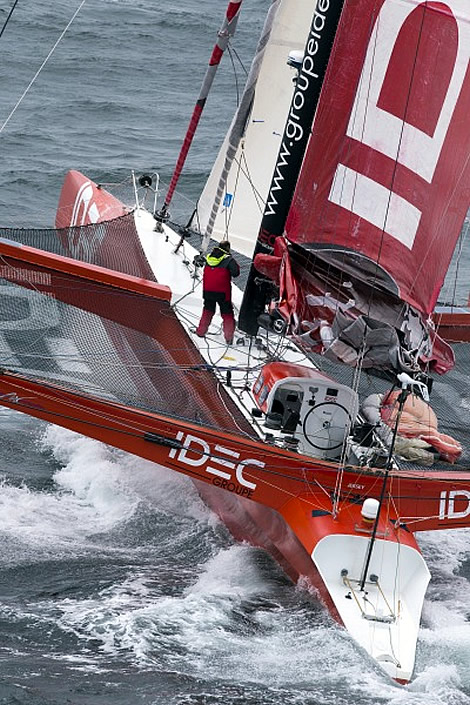

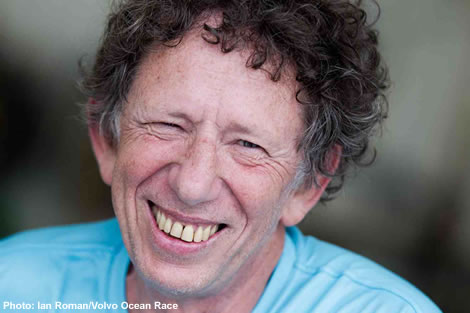
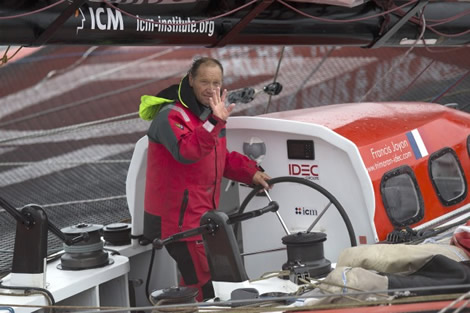
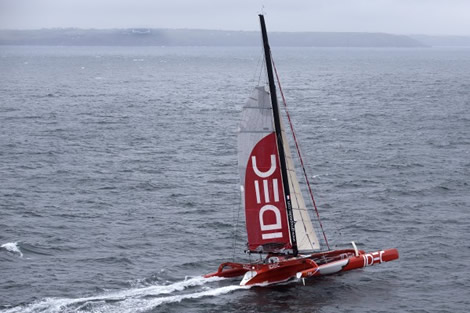

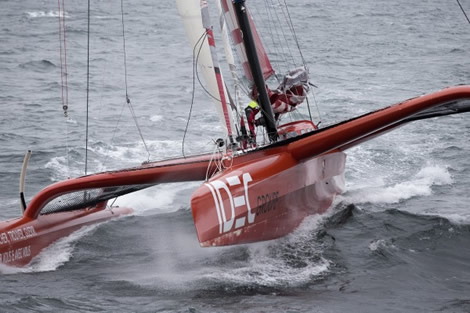








Latest Comments
Add a comment - Members log in